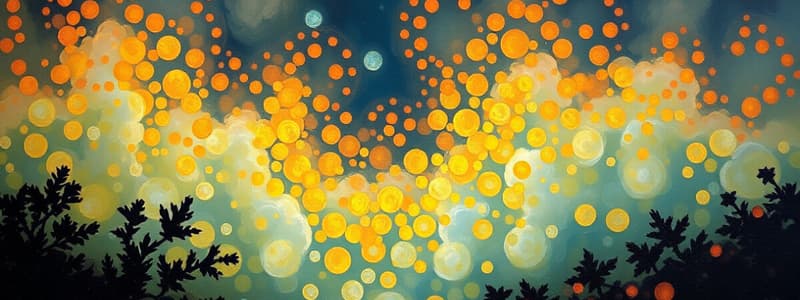Podcast
Questions and Answers
What does the Periodic acid-Schiff (PAS) stain indicate about glycogen?
What does the Periodic acid-Schiff (PAS) stain indicate about glycogen?
- It does not stain glycogen.
- It stains glycogen red. (correct)
- It stains glycogen blue.
- It stains glycogen yellow.
What cellular feature is highlighted by Hematoxylin and Eosin (H&E) staining in hepatocytes with excessive glycogen accumulation?
What cellular feature is highlighted by Hematoxylin and Eosin (H&E) staining in hepatocytes with excessive glycogen accumulation?
- Cell membrane thickening.
- Nuclear enlargement.
- Clear cytoplasm. (correct)
- Dark granules.
What is a characteristic appearance of hyaline droplets in the renal proximal tubules?
What is a characteristic appearance of hyaline droplets in the renal proximal tubules?
- Translucent and pink material (correct)
- Fibrillar and cloudy material
- Yellow and granular material
- Dense and opaque material
In which condition are Russell bodies most commonly found?
In which condition are Russell bodies most commonly found?
What appearance does the term 'hyaline' describe regarding protein accumulation?
What appearance does the term 'hyaline' describe regarding protein accumulation?
Which type of accumulation is characterized by the substances such as water, protein, lipid, carbohydrate, mineral, and pigment?
Which type of accumulation is characterized by the substances such as water, protein, lipid, carbohydrate, mineral, and pigment?
What happens to hyaline droplets if proteinuria diminishes?
What happens to hyaline droplets if proteinuria diminishes?
What kind of proteins accumulate in extracellular conditions associated with gout?
What kind of proteins accumulate in extracellular conditions associated with gout?
What does excessive intracellular glycogen accumulation typically result in within liver cells?
What does excessive intracellular glycogen accumulation typically result in within liver cells?
Which of the following statements correctly describes the term 'hyaline'?
Which of the following statements correctly describes the term 'hyaline'?
Flashcards are hidden until you start studying
Study Notes
Accumulation of Glycogen
- Excessive intracellular glycogen accumulation can be identified with special staining.
- Periodic Acid-Schiff (PAS) stain causes glycogen to appear red.
- Hematoxylin and Eosin (H&E) stain shows swollen hepatocytes with clear cytoplasm, indicating increased glycogen levels.
Types of Accumulation
- Accumulation can be categorized as endogenous (internal) or exogenous (external).
- Main types of intracellular accumulations: water, protein, lipid, carbohydrate, mineral, and pigment.
- Extracellular accumulations mirror intracellular types.
Accumulation of Protein
- Proteins exhibit an eosinophilic appearance, contributing to hyaline characteristics.
- Hyaline is a transparent, eosinophilic, homogeneous substance.
- Intracellular protein accumulations can indicate pathological changes, such as:
- Hyaline droplets in kidneys and intestines.
- Russell bodies in plasma cells, often seen in autoimmune disorders.
Specific Protein Accumulation Conditions
- Hyaline droplets originate from protein leakage in glomerular diseases, often reversible when proteinuria decreases.
- Russell bodies appear in plasma cells synthesizing immunoglobulins, causing distension of the endoplasmic reticulum.
Hyaline Cast & Membranes
- Hyaline casts form due to excessive protein leakage, creating casts in the tubular lumen during glomerular diseases.
- Hyaline membranes are associated with Acute Respiratory Distress Syndrome (ARDS); they consist of fibrin-rich edema fluid.
Amyloidosis
- Amyloidosis involves protein misfolding, leading to extracellular deposition of fibrillar proteins.
- Affected tissues show a characteristic purple color when stained with lugol’s iodine and diluted sulfuric acid.
- Congo red stains amyloid deposits orange-red and reveals apple-green birefringence under polarized light.
Gout
- Gout involves uric acid crystal deposition, primarily sodium urates, in tissues.
- Occurs mainly in humans (articular gout) and birds (visceral gout); rare in other animals due to uricase enzyme.
- Articular gout causes swollen, inflamed joints with detectable tophi.
- Visceral gout is prevalent in birds and observed on serosal membranes, ureters, and renal tubules.
Pathologic Calcification
- Pathologic calcification refers to abnormal calcium salt deposition (usually calcium phosphate or carbonate) in soft tissues.
Studying That Suits You
Use AI to generate personalized quizzes and flashcards to suit your learning preferences.


